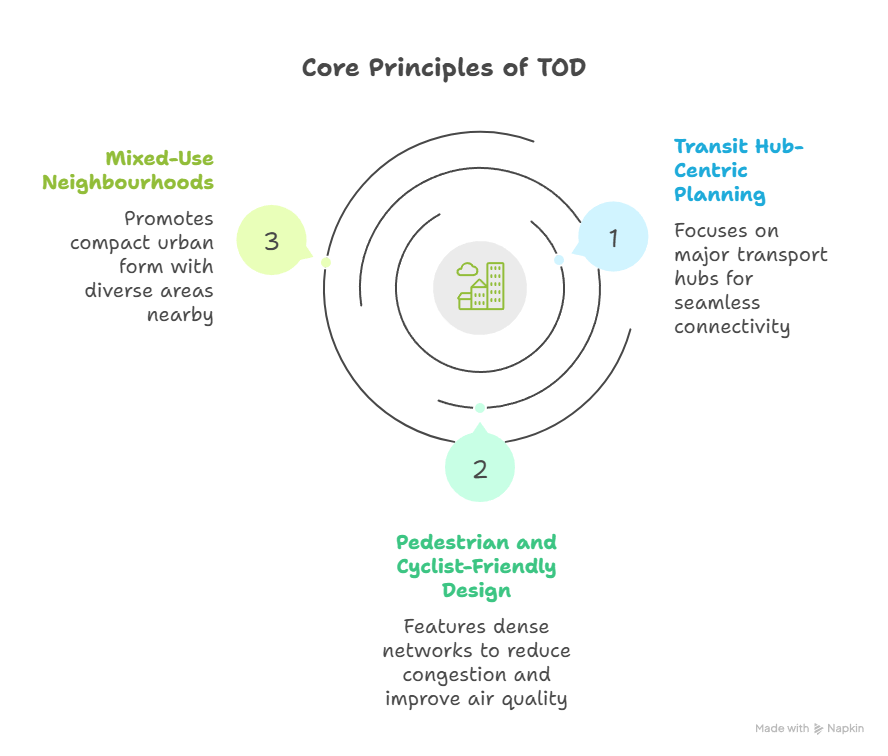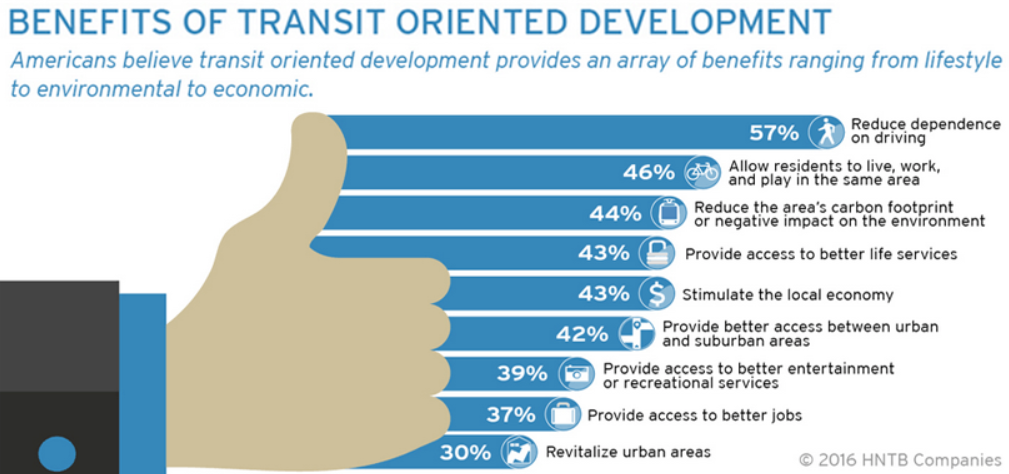Indian Economy
Transit-Oriented Development for Urban Sustainability
- 31 Oct 2025
- 9 min read
For Prelims: National Transit-Oriented Development Policy (2017), Urban Infrastructure Development Fund (UIDF), Multi-Modal Transport Hub (MMTH), Economically Weaker Sections (EWS), GIS Mapping.
For Mains: Transit-Oriented Development: Features, Significance, Challenges, and Way Forward for Sustainable Urban Development.
Why in News?
The 48-storey 'Towering Heights' in East Delhi is India’s first transit-oriented development (TOD) project, marking a shift from car-centric planning to integrated, sustainable urban living.
What is Transit Oriented Urban Development?
- About: TOD is an urban planning strategy that promotes high-density, mixed-use development around public transport hubs such as metro or railway stations.
- It aims to make public transport the focal point of city development, contrasting with car-centric urban sprawl.
- Core Principles of TOD:
- Objective: Reduce dependence on personal vehicles.
- Shorten travel distances and time.
- Lower pollution levels and commuting costs.
- Encourage walkable, pedestrian-friendly neighbourhoods.
- 3V Framework by World Bank for TOD:
- Node Value: It refers to a station’s importance within the public transit network, determined by passenger traffic, intermodal connections, and its central position in the network.
- Place Value: It reflects the quality and appeal of the station area, based on land use diversity, access to services, nearby amenities, walkability, and urban block size.
- Market Potential Value: It indicates the market potential of station areas, assessed by job density, transit accessibility, housing density, development land, zoning scope, and market activity.
Why is Transit-Oriented Development (TOD) Significant for Urban Development?
- Combating Traffic Congestion and Pollution: Road-centric planning causes traffic jams, fuel waste, and pollution, harming public health. TOD creates walkable, transit-linked neighborhoods, cutting commutes, reducing car use, and improving air quality.
- Managing Urban Sprawl: Urban sprawl causes inefficient land use and high infrastructure costs. TOD encourages vertical, compact growth around transit stations (500–800 m radius), preserving open spaces and optimizing urban land use.
- Financial Viability of Public Transport: Metro system is capital-intensive, but TOD ensures high ridership through dense development near stations. It also enables Value Capture Financing, using rising land values to fund construction and maintenance.
- Reducing Carbon Footprint: TOD cuts car use, commute times, and carbon emissions while boosting productivity. In Stockholm, transit-based growth raised economic value by 41% and cut emissions by 35% (1993–2010).
- Boosting Economic Competitiveness: TOD promotes higher densities and job clustering, enhancing city competitiveness—doubling job density can raise economic productivity by 5–10%.
What are the Concerns Associated with Transit-Oriented Development Projects in India?
- High Initial Costs: TOD demands high upfront investment for land acquisition and mixed-use development, often exceeding public funding. It can also raise property prices, causing displacement and undermining inclusive growth.
- Design Challenges: TOD can fail without last-mile connectivity, such as safe walkways, cycling lanes, and feeder buses. Car-centric planning and infrastructure pressure on water, sewage, and public amenities further hinder its success.
- Fragmented Institutional Framework: Overlapping roles of urban local bodies, metro corporations, and state governments, along with the lack of a unified transport authority, lead to coordination gaps and planning delays.
- Higher Population Density: Weak regulations can cause uneven development, overburdening high-density areas while leaving others underdeveloped and poorly connected.
- Limitations in Indian Context: In island cities like Hong Kong and Singapore, TOD maximizes land use efficiency and reduces urban sprawl, but may be less suited to cities like New Delhi or Bengaluru.
National Transit Oriented Development (TOD) Policy, 2017
- About: The Ministry of Housing and Urban Affairs (MoHUA) launched the National Transit-Oriented Development Policy (2017) to guide states and cities in adopting TOD-based urban growth.
- Vision:
- Promotes public transport and green mobility, reducing pollution and congestion.
- Encourages compact, walkable, and affordable neighbourhoods with dense infrastructure.
- Shifts focus from private vehicles to public transport-oriented development.
- Integrates inclusive and affordable housing for all income groups.
- Enhances recreation, safety, and environmental sustainability through eco-friendly travel options.
- Initiatives Taken for TOD Development in india:
What Steps are Needed to Implement TOD for Sustainable Urban Development?
- Policy and Regulatory Reforms: Integrate TOD into city plans, zoning laws, and regulations, with uniform norms for land use, density norms, and parking. Make TOD implementation mandatory for all new metro and mass transit corridors.
- Institutional Coordination: Set up a Unified Metropolitan Transport Authority (UMTA) in major cities to coordinate transport, housing, and urban planning, with formal protocols for inter-agency coordination and synchronized execution.
- Financing and Incentives: Adopt Value Capture Financing (VCF) tools like land value tax, development charges, or extra Floor area ratio (FAR) to fund TOD projects.
- Provide developer incentives and promote PPP models for infrastructure and mixed-use development.
- Inclusive and People-Centric Design: Reserve Economically Weaker Sections (EWS) and Low-Income Groups (LIG) housing in TOD zones for social inclusivity and offer rental or hostel accommodations near transit hubs for workers and students.
- Data-Driven Planning and Monitoring: Use GIS mapping and data analytics to plan TOD zones and set performance metrics (e.g., reduced travel, higher ridership, walkability, social mix) for regular monitoring.
Conclusion
Transit-Oriented Development is a crucial paradigm shift for sustainable urban India, combating sprawl, congestion, and pollution. While the National TOD Policy 2017 provides a roadmap, its success hinges on overcoming financial, institutional, and inclusivity challenges through integrated governance, innovative financing, and people-centric design to build truly livable cities.
|
Drishti Mains Question: Q. Transit-Oriented Development (TOD) is often hailed as a solution to India's urban woes. Critically examine its potential in ensuring sustainable and inclusive urban growth |
Frequently Asked Questions (FAQs)
What is Transit-Oriented Development (TOD)?
TOD is a planning approach that promotes high-density, mixed-use development within walking distance (typically 500–800 m) of public transit stations to reduce car dependence and increase transit ridership.
What are the three core principles of TOD?
The three core principles are: Transit Hub-Centric Planning, Pedestrian and Cyclist-Friendly Design, and the creation of Dense Mixed-Use Neighbourhoods.
What is the objective of the National Transit-Oriented Development Policy (2017)?
Its vision is to transform urban development by shifting from private vehicle dependence to public transport-oriented development, creating walkable communities and reducing pollution and congestion.
UPSC Civil Services Examination, Previous Year Questions (PYQs)
Mains
Q. How is efficient and affordable urban mass transport key to the rapid economic development in India? (2019)
Q. With a brief background of quality of urban life in India, introduce the objectives and strategy of the ‘Smart City Programme.” (2016)








